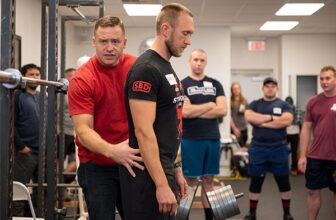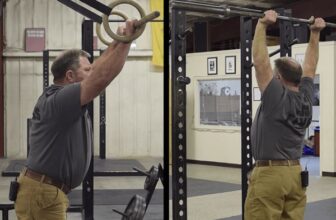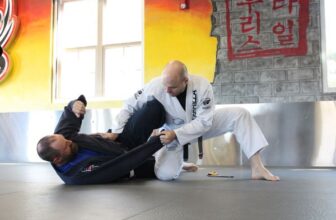
[adinserter block=”2″]
Yes, Go The Hell In!
by Amanda Sheppard | April 18, 2023
You might be asking yourself what the
question could be that results in the answer, “Yes, go the hell
in.” And I can almost guarantee that if you have been lifting for
any significant period, adding weight to the bar consistently, and
wondering if there was ever going to be an end to the ever-increasing
load on the bar, that you’ve asked yourself this question. “(Insert
body part) hurts” or “I felt a pain in (insert spot on your
body), should I go into the gym today?” The answer, more than
likely, is Yes, go the hell in.
Now I am not talking to the people that
have a contraindication to training involving neurological symptoms,
cardiovascular issues, or broken bones that require diagnosis and
treatment. I am talking to the overwhelming majority of people that
have a sore or “tweaked” back, an achy joint, or even a mild to
moderate muscle belly injury, which some might treat as severe.
Don’t run to your chiropractor,
massage therapist, or acupuncturist and expect them to tell you
anything other than take two weeks off and to see them repeatedly for “X” number of sessions until they can resolve the issue
and you can return to lifting. I’m not hating on these
people – well maybe I am, but I also envy them because their
argument from authority seems to have a strong hold on a lot of
people. Who I won’t hate on is an intelligent physical therapist
or one of the above who understands the application of
stress/recovery/adaptation and how it applies to physical activity.
I know a good handful of them who work
tirelessly to change the traditional thought process, but I still
repeatedly run into those in the ever-so-risk-averse healthcare
system that would rather keep you “safe” by telling you not to do
something so they’re not at risk of a lawsuit. Instead, they should
be guiding your care by allowing you to use their passive modalities
for acute relief when it’s necessary, and then shipping you back to
the gym to progressively overload the tissues – or doing it with
you, as you can tolerate, in order to elicit the same or similar
adaptations you’d been trying to cause when the episode happened.
So, what gives? Why would you trust
some random strength coach and not immediately catastrophize the
situation, like your doctor would do? Well, I guess you must answer
that for yourself. But there’s a rather simple process that can be
used when trying to determine what you can tolerate for the day you
decide to go into the gym.
Load
Management
If you’re trying to decide if you
should go to the gym today, and you have already been training, then
there’s a good probability that you have a workout scheduled with
loads you were going to hit. Once you arrive at the gym do some bike,
treadmill, and bodyweight exercises, just get your blood flowing and
get your heart rate up so your body recognizes that you’re going to
start some sort of activity.
After you’ve done that for about 5
minutes step over to your bar and take the same process you would if
you felt fine. You’re going to be uncomfortable, and I guarantee
you’re going to ask yourself repeatedly through the first few sets
why you decided to come in. Take the squat for instance: you’re
going to put the bar on your back and bent over, it’s probably
going to be high, then you’ll get back to the top and decide if you
can tolerate another rep. After you do a few sets at the empty bar
you are going to be able to decide if you can do a weighted warmup.
If you’ve made it this far then you’ve won half the battle
already.
I have had clients that have come into
the gym and done a bunch of sets at the empty bar, and maybe for that
day and the way they were moving that was plenty. So, we decided to
go on to the next movement. If you decide to do a weighted warmup
it’s okay to start lighter than what you usually do. If 135 lb is
usually your first warmup then choose 95, but if 95 is usually first
then do 65. Not that complicated. It doesn’t matter where
you start, just that you do.
It’s at this point you’ve solidly
planted your feet in the load management adjustment of your workout.
This is a great spot to be because you have kept your workout as
close to the primary exercises as you could. Honestly, this is very
promising because your body will be able to determine what you are
able to tolerate for that day by still eliciting a pain or discomfort
response to guide your decision-making process. If this is the first
time this has happened to you then maybe the bar and full range of
motion is an extremely daunting task, so there is another option.
Range
of Motion
A main criterion of the way we decide
what movements are not only effective but efficient is doing each
lift over the greatest effective range of motion (ROM). In
every movement there is the possibility to do more ROM and a definite
the ability to do less ROM. I don’t recommend either of these, for
reasons that have been explained ad nauseum in the books and in
articles available on this website.
That being covered, if the ROM that is
required regularly elicits the not-so-fun pain response, then maybe
there is a ROM that you can not only tolerate, but actually load. A
couple examples of this would be rather straightforward: high-box
squat, rack pull, pin press. Each of those movements limit the ROM
that is being performed but could, and will, allow you to continue to
stress your body in a way that is necessary in order to deal with the
hand you’ve been dealt for that day.
There will be some nuanced movement
pattern adjustments that may be necessary when you do partial
movements, but that is beyond the scope of this piece. If you have a
coach talk with him about this. If you don’t, then find a coach that
could help you navigate this further if you need to.
Up to this point you have been able to
keep your modifications rather simple, and the hope is that after
just a couple of sessions this will allow you to get yourself back in
order and back to training the way you should.
The
other thing you’ve been able to do is to learn to navigate the
waters of an acute injury, and that will indeed happen again in your
lifting lifetime. It’s not intentional, it’s not preferred, but
it is a normal and common occurrence among individuals that push
themselves hard enough to cause a strength adaptation. If you get to
this point and neither option has enabled you to continue to train,
there is another option.
Exercise
Selection
I mentioned that the greatest effective
range of motion is a criterion of the exercise selection that is used
in the Starting Strength model. The other criterion is that each of
the movements allows you to use the greatest amount of muscle mass.
These two things together will then enable you to lift the most
weight, and it is through this process that you become a stronger and
more capable human being. With that being the case, you will want to
use the basic lifts for most of your training in order to make your
time in the gym more effective and efficient.
However, if it becomes necessary for
reasons outside of programming to choose a different exercise in
order to train for the day, then you’d better damn well do it. What’s
the other choice? Not train? Unfortunately that is a choice too many
people make because they rely on motivation and comfort level in
order to decide show up.
There are a lot of movements to choose
from when satisfying exercise selection. For instance, if I can’t
squat with the bar in the low-bar position, can I high-bar, can I
front squat, or can I use a safety squat bar? Then you need to make
that modification and squat the load you can for your prescribed sets
and reps. You know exactly how hard it should be so don’t give
yourself the excuse of a new movement to lighten the load arbitrarily
if the movement feels fine. Go train! You now have a process and some
tools to use in order to make decisions that will allow you to
continue to train – because that is what we are doing: training.
We are not exercising. We are not going light to work on technique.
We are not doing this to just say that we lift. We are training in
order to accumulate the adaptation of producing more force. But I
know things don’t always go as planned.
What went wrong?
There are a ton of variables involved
in how you feel going into a workout. Did you get enough sleep? Did
you eat enough? How are the added stress variables of your life going
(i.e., work, kids)? Out here in the Pacific Northwest, if the sun
isn’t out everyone is depressed. If I waited to get under the bar
until everything felt absolutely perfect, then I would never train.
It is an absolute fantasy that you will always feel good. Your
emotional state and the connection to your pain plays an enormous
roll in this as well. Will Morris and Rip talk about this in a recent SS Radio podcast.
Now I didn’t say that being
under-recovered or not applying appropriate stress with programming
isn’t of utmost importance, but everyone is dealing with something
in their lives. Which is why training has to be a priority and not a
hobby, such as playing an instrument or knitting. It’s hard, but
it’s supposed to be because, as the cliché goes, progress
begins at the end of your comfort zone. But don’t ask your body
to give you results that you haven’t worked towards. And this
requires that the recovery (sleep) and nutritional aspects of the
process be covered.
I won’t sit here and tell each of you
reading this that I know exactly what went wrong to cause your
episode of pain. If you are optimizing every aspect of your approach
to training and managing your stress correctly you will be able to
decide what should change moving forward. But on the other hand,
sometimes shit happens and you can ask yourself a bunch of questions
trying to figure out what went wrong. But you can always figure out
how to get something done in the gym, no matter what happened. I can
almost guarantee you that when you ask yourself if you should go to
the gym, the answer will be… Yes, go the hell in!
[adinserter block=”2″]
Credit : Source Post






